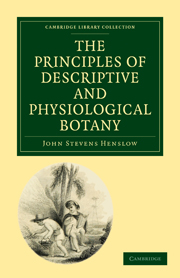Book contents
- Frontmatter
- Contents
- INTRODUCTION
- PART I DESCRIPTIVE BOTANY
- SECTION I ORGANOGRAPHY AND GLOSSOLOGY
- SECTION II TAXONOMY AND PHYTOGRAPHY
- PART II PHYSIOLOGICAL BOTANY
- CHAPTER I VITAL PROPERTIES AND STIMULANTS
- CHAPTER II FUNCTION OF NUTRITION — Periods 1, 2, 3, 4
- CHAPTER III FUNCTION OF NUTRITION — continued — Periods 5, 6
- CHAPTER IV FUNCTION OF NUTRITION — continued — Period 7
- CHAPTER V FUNCTION OF REPRODUCTION — Periods 1, 2, 3
- CHAPTER VI FUNCTION OF REPRODUCTION — continued — Periods 4, 5
- CHAPTER VII EPIRRHEOLOGY, BOTANICAL GEOGRAPHY, FOSSIL BOTANY
- INDEX AND GLOSSARY
CHAPTER VI - FUNCTION OF REPRODUCTION — continued — Periods 4, 5
Published online by Cambridge University Press: 05 December 2011
- Frontmatter
- Contents
- INTRODUCTION
- PART I DESCRIPTIVE BOTANY
- SECTION I ORGANOGRAPHY AND GLOSSOLOGY
- SECTION II TAXONOMY AND PHYTOGRAPHY
- PART II PHYSIOLOGICAL BOTANY
- CHAPTER I VITAL PROPERTIES AND STIMULANTS
- CHAPTER II FUNCTION OF NUTRITION — Periods 1, 2, 3, 4
- CHAPTER III FUNCTION OF NUTRITION — continued — Periods 5, 6
- CHAPTER IV FUNCTION OF NUTRITION — continued — Period 7
- CHAPTER V FUNCTION OF REPRODUCTION — Periods 1, 2, 3
- CHAPTER VI FUNCTION OF REPRODUCTION — continued — Periods 4, 5
- CHAPTER VII EPIRRHEOLOGY, BOTANICAL GEOGRAPHY, FOSSIL BOTANY
- INDEX AND GLOSSARY
Summary
(275.) Dissemination. — The manner in which the ripe seed is disseminated, forms a more important element in the history of the preservation of species than might at first be imagined. It may be considered analogous to the period of labour in the animal kingdom, and still more strictly to the laying of eggs among such as are oviparous. If the different modes of dissemination were not in harmony with the peculiar character of the species, we might expect in the lapse of ages that some combination of circumstances would arise which should so far interfere with the reproduction of a given species that it would disappear from the earth. This is guarded against by some peculiar adaptation of the mode in which the seed is disseminated to the conditions under which each species naturally thrives the best. In some cases, the seed falls immediately around the parent plant; and where many seeds are contained in the same seed-vessel, the young plants come up in a crowded manner and occupy the soil in society, to the exclusion even of more robust species. Other seeds and seed-vessels are furnished with the means of being transported by the influence of the wind or by some other cause to a considerable distance. The great diversity in the means by which the dissemination of the seed is naturally secured forms one important inquiry to the botanical geographer; and a complete description of the various appendages by which their dispersion is assisted would form an interesting topic of inquiry.
- Type
- Chapter
- Information
- The Principles of Descriptive and Physiological Botany , pp. 276 - 290Publisher: Cambridge University PressPrint publication year: 2009First published in: 1835



